Hybrid work is reshaping workplace management, demanding flexible spaces, smart tech integration, and a focus on employee experience. This guide breaks down what it actually means with essential strategies to optimize your office, enhance productivity, and create a workplace that thrives in the modern era.

Imagine your workplace five years from now. How will it look and operate?
Traditional office dynamics have transformed beyond recognition. Remote work surges, employee expectations shift, and technological breakthroughs continuously reshape our work environments. These changes demand sophisticated workplace management approaches that few organizations have mastered.
Workplace managers today must manage multiple critical responsibilities. Space optimization, employee satisfaction, and operational excellence require careful orchestration. The emergence of hybrid workspaces calls for fresh management perspectives—ones that seamlessly blend time-tested principles with cutting-edge solutions.
Ready to master modern workplace management? This comprehensive guide unlocks essential strategies, core concepts, and practical implementations that drive organizational success. Whether you’re new to workplace management or seeking to enhance your existing approach, you’ll discover actionable insights to navigate today’s complex work environment.
Understanding Modern Workplace Management
The digital revolution has fundamentally reshaped workplace management landscapes. Success now demands mastery of core elements that power modern organizational efficiency.
What is workplace management?

Think beyond traditional office administration. Workplace management orchestrates your organization’s physical spaces, operational workflows, and resource allocation to create high-performance work environments. This strategic framework ensures frictionless operations while maximizing facilities management effectiveness.
Since 2023, 93% of organizations surveyed in the Foundry study have embraced or planned to implement digital-first business strategies. Traditional hierarchies crumble as collaborative, tech-powered environments take center stage.
Yet, smart leaders recognize that technology alone cannot guarantee success. Many digital transformation efforts fall short of expectations, often because they prioritize tools over strategy or forget to address the human side of change. True transformation requires more than just new software or systems. It demands a clear vision, cross-functional collaboration, and a deep focus on empowering people to embrace new ways of working.
To meet the demands of the modern workplace, it is essential to integrate digital workflows holistically while emphasizing human-centric approaches. When technology aligns with organizational goals and employee needs, it creates an environment where innovation thrives and teams succeed.
The Five Pillars of Effective Workplace Management

Managing a workplace is no small feat, but you don’t have to reinvent the wheel. The following five key pillars are essential to building a work environment that thrives, whether you’re navigating hybrid setups or tackling the latest challenges in employee engagement.
1. Communication Infrastructure
Clear and strategic communication is the lifeblood of any thriving organization. You need systems that work for both in-office and remote teams, balancing real-time updates with asynchronous communication.
2. Space Optimization
Forget about fixed office arrangements. Today’s workplace emphasizes flexibility, which satisfies one of the top demands of employees while also enhancing companies’ ability to adapt in the modern era. It’s essential to think outside the box regarding the utilization of physical and virtual spaces. Consider implementing hot desks, crafting collaborative areas, or improving the fluidity of virtual meetings.
>> For more guidance on this, check out our piece on Space Management.
3. Technology Integration
Let’s be real: Tech can either make your life easier or turn it into a headache. By choosing and implementing tools thoughtfully, you can streamline workflows, reduce bottlenecks, and empower your team to focus on what matters most. Remember, it’s not about having the newest gadgets; it’s about creating a tech stack that works for you and your teams.
4. Employee Experience
A great workplace isn’t just about fancy perks; it’s about making employees feel valued and supported. Think flexible schedules, wellness programs, and spaces that inspire creativity and collaboration. When your team feels good, they’ll do their best work—it’s as simple as that.
5. Resource Management
Last but not least, the way you manage resources is critical to keeping your workplace efficient and sustainable. It’s about using what you already have—budget, equipment, and even time—to maximize output without stretching your team too thin or wasting valuable assets.
Smart resource management ensures that every asset is put to its best use, reducing waste and preventing shortages. Whether it’s optimizing energy consumption, tracking office supplies, or reallocating team bandwidth, a well-managed workplace is one where nothing is overlooked.
Creating Flexible Work Environments
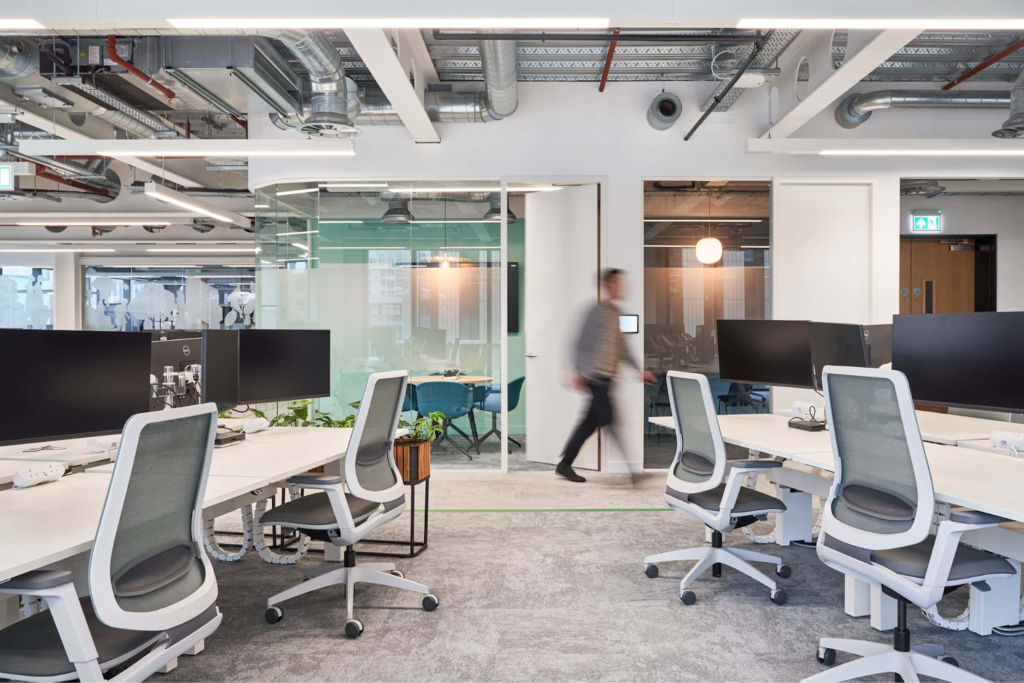
With the foundational pillars in place, let’s explore some of the most effective strategies and best practices for modern workplace management. The first one worth considering is designing flexible work environments that empower productivity and adaptability.
Flexible work is no longer a preference but a necessity. Forward-thinking workplace leaders recognize the importance of creating environments that cater to diverse work styles and changing employee expectations.
By reimagining office spaces as adaptable, inclusive hubs, they can strike a balance between fostering collaboration and supporting focused individual work.
Hybrid Workplace Design Principles
To design a workspace that thrives in today’s hybrid work landscape, you need to prioritize flexibility and intentionality. Modern hybrid offices should include:
- Collaboration Hubs: Spaces designed to foster teamwork and idea-sharing.
- Quiet Zones: Areas optimized for deep, focused work.
- Social Spaces: Casual meeting spots that encourage spontaneous connection.
- Tech-Enabled Meeting Rooms: Equipped with tools for seamless virtual and in-person collaboration.
- Smart Storage Solutions: Organized spaces that reduce clutter and improve workflow.
These elements ensure your workspace adapts to fluctuating attendance patterns and varied employee needs. For deeper insights, check out our guide on Hybrid Office Spaces.
Hot Desking and Space Sharing
As traditional office utilization rates decline, more companies are embracing hot desking and space-sharing models. These approaches allow employees to reserve workspaces on demand, reducing underused areas and fostering flexibility.
Here’s how to implement hot desking effectively:
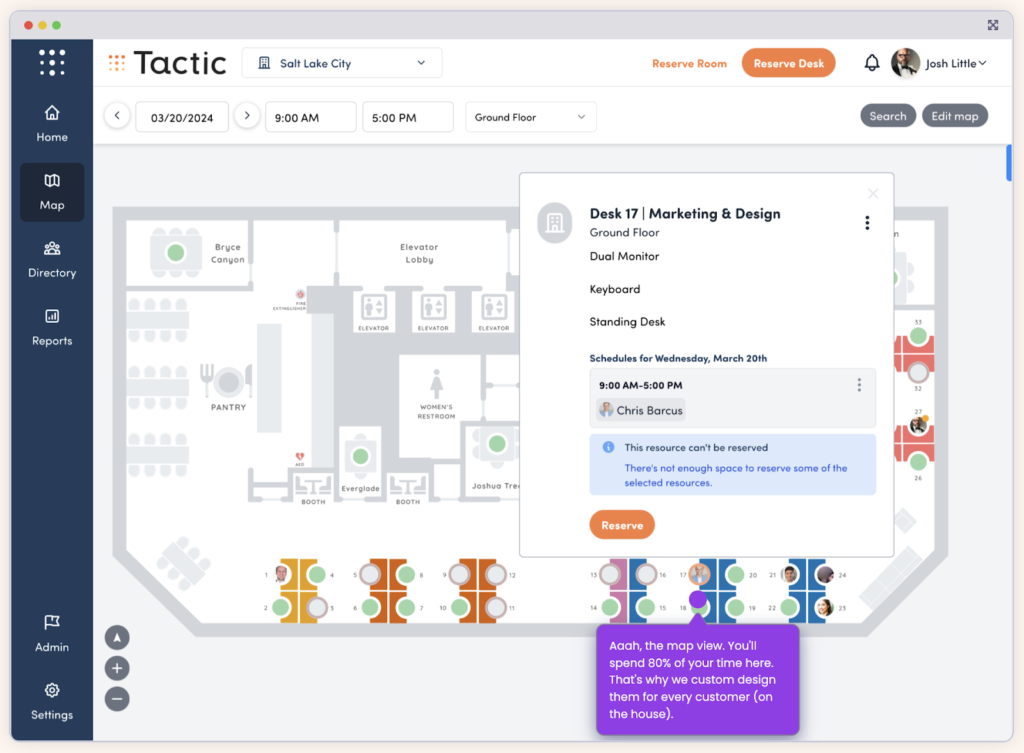
- Desk Booking Systems: Platforms like Tactic simplify the reservation process, allowing employees to book their preferred workstations effortlessly. This eliminates the stress of searching for a spot on busy days.
- Clear Usage Policies: Establish guidelines that make the system intuitive and ensure fair access for everyone.
Hot desking, when paired with a reliable and employee-friendly booking platform, can save costs, improve space efficiency, and enhance the employee experience. If you’re planning to adopt this model, check out Tactic Desk Booking Software, the #1 G2-rated solution in the category.
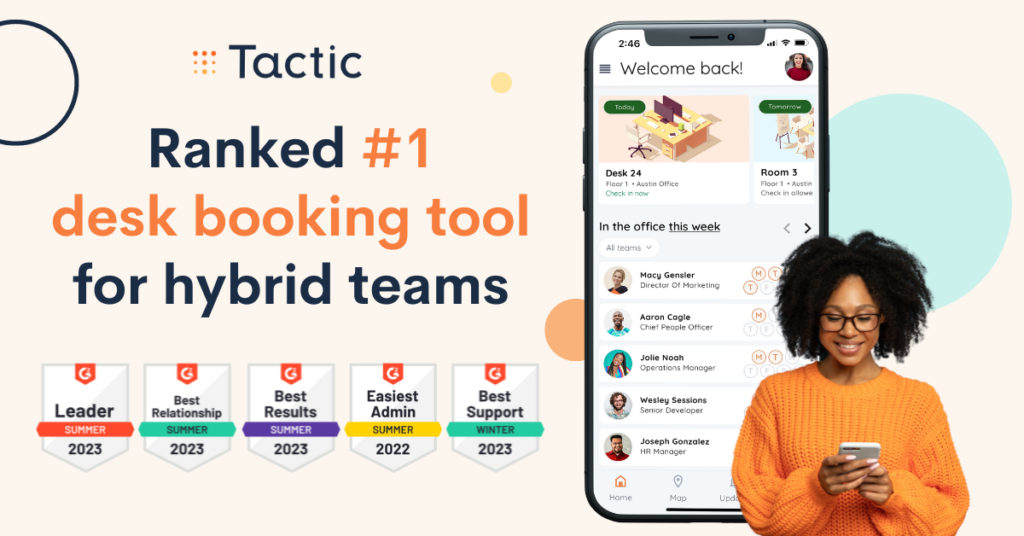
Technology for Flexible Work Management
Technology plays a central role in managing flexible workplaces. The right tools don’t just support hybrid arrangements; they make them seamless and engaging. Equip your workplace with:
- Desk and Room Booking Platforms: Tools to streamline space reservations and reduce administrative overhead.
- Video Collaboration Tools: Ensure clear communication for hybrid teams with enterprise-grade video solutions.
- Presence Tracking Systems (nice to have): Gain real-time visibility into workspace occupancy to avoid overbooking or underutilization.
- Space Analytics Platforms: Use data to identify trends and optimize your office layout based on actual usage.
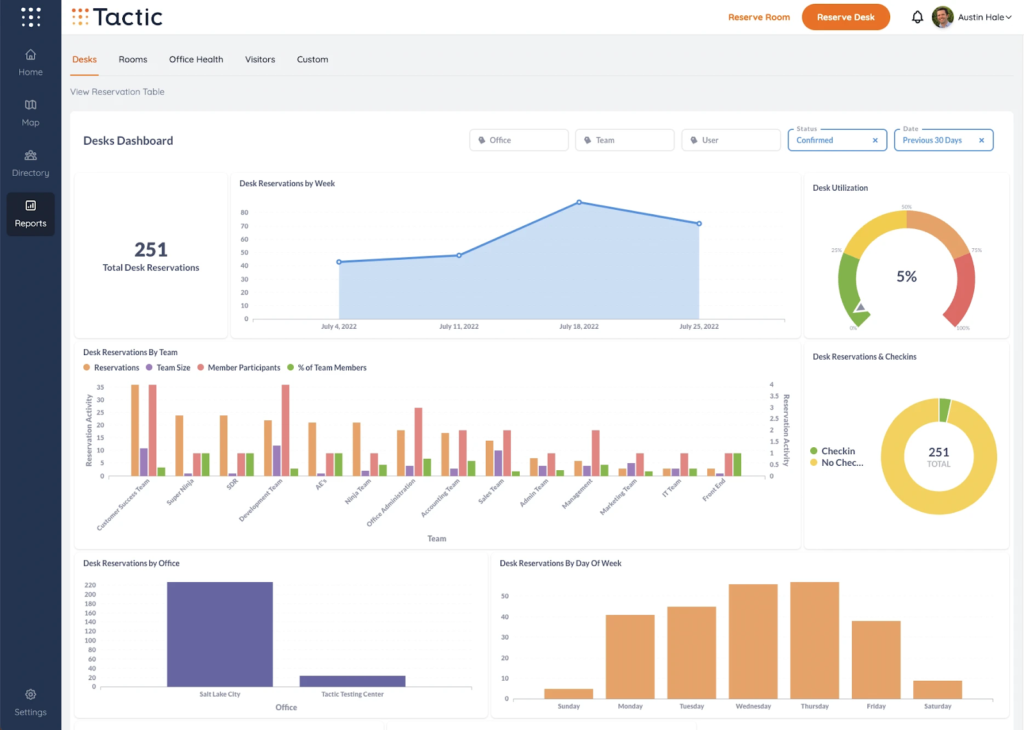
Workplace management software like Tactic can help you gain valuable insights into office usage and trends. (Book a FREE demo with us here.)
The Human Side of Workplace Management

People power every workplace. Yet, it’s easy to get caught up chasing technological solutions and forget what truly drives success—your team. Modern workplace management demands a shift in focus, prioritizing employee experience, fostering a strong culture, and embracing diversity to create environments where everyone can thrive.
Employee Experience and Satisfaction
A thriving workplace begins with employees who feel supported, valued, and connected to their work. Start by prioritizing purposeful communication. When employees know their voices are heard and their input matters, they’re more engaged and motivated.
Regularly gather feedback through surveys, one-on-one check-ins, or team forums to uncover opportunities for improvement. For example, if hybrid team members feel disconnected, use that insight to build moments for intentional collaboration, whether through technology or planned in-office days.
The right tools also play a role in enhancing satisfaction. Platforms like Tactic empower employees to align their work environment with their needs, whether reserving a quiet zone for focused tasks or collaborating in tech-enabled spaces. Giving employees this level of flexibility makes their time in the office more meaningful and productive.

When employees feel heard, supported, and equipped with spaces and tools that meet their work preferences, the result is an engaging and productive workplace.
Building Workplace Culture
While employee experience focuses on meeting individual needs, workplace culture defines the collective experience. It’s the invisible thread that connects your team, creating a sense of shared purpose and belonging.
With hybrid teams, building culture requires thoughtful effort. Start by creating moments for both formal and informal connections. Dedicated team-building sessions, whether in-person or virtual, foster collaboration, while casual office spaces like lounges or breakout zones encourage spontaneous interactions. On the virtual side, consider fostering community through interest-based Slack channels or monthly video check-ins for non-work discussions.
Recognition is also vital. Acknowledging achievements—big or small—reinforces positive behaviors and boosts morale. Recognition doesn’t have to be elaborate. Simple practices, like a team shoutout or a personal thank-you email, can go a long way in building trust and connection.
Leaders and managers play a critical role in shaping culture. Transparency, fairness, and accessibility are foundational. When leadership reflects the organization’s values and actively engages with employees, it sets a clear tone that culture is not just a concept but a daily practice.
Managing Diverse Workplace Needs
Diversity encompasses more than demographics; it involves understanding and addressing the diverse needs, preferences, and work styles within your team. Supporting diversity truly requires flexible and inclusive workplace strategies at all levels.
Start by acknowledging that managing diversity entails more than just offering flexibility; it’s about fostering an environment where every employee feels valued, included, and supported.
Flexibility is crucial, whether through hybrid work schedules, designated quiet areas for focused work, or collaborative spaces that inspire creativity. Providing options like reservable desks and adaptable meeting rooms ensures employees can access environments that cater to their individual needs.
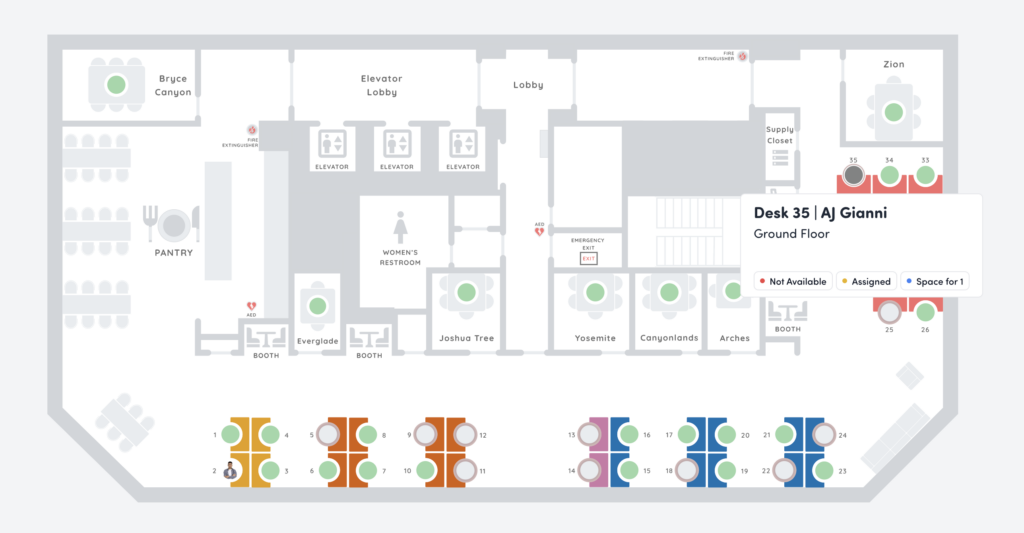
Caption: Tactic customizes interactive maps to fit each company’s unique hybrid office space. (Book a FREE demo with us here.)
Inclusivity also demands careful design and communication. Designing accessible office layouts, making accommodations for neurodiversity, and providing resources in multiple languages (many AI tools now can help with this!) show respect for your team’s diversity. Furthermore, offering equitable opportunities for growth and development is essential. Initiatives such as mentorship programs and transparent career pathways create systems that promote fairness, building trust and engagement within your workforce.
Finally, keep in mind that diversity is not a one-time achievement. Establishing regular feedback mechanisms, encouraging open dialogue, and committing to continual improvement ensures your workplace stays inclusive and adaptable over time. These initiatives are not merely about addressing individual needs; they represent a culture where everyone feels they belong and can contribute their best.
Safety and Compliance Management
Safety and compliance might not be the most exciting aspects of workplace management, but they’re among the most critical. Protecting employees and adhering to regulations not only prevent costly incidents but also build trust and accountability across your organization. The goal is to make safety part of your daily routine so it feels natural and effective.
Workplace Safety Protocols
Safety isn’t a one-and-done task. Regular check-ins and reviews help you adjust as risks change and make sure everyone stays protected. Here’s how to keep safety practical and effective:
- Regular Equipment Checks: Set a schedule to inspect tools and machines. Fix small issues before they turn into big problems.
- Clear Hazard Warnings: Mark risks clearly with signs that employees can easily understand. Go beyond posting signs and train people to handle these risks.
- Updated Procedures: Keep workplace processes up to date. If something changes, like new equipment or layouts, make sure everyone knows the new steps.
- Hands-On Training: Offer simple, practical training that shows employees what to do in emergencies or risky situations. Use examples and demonstrations rather than long lectures.
- Incident Records: Keep a log of any workplace incidents and review it regularly. Use this information to identify and fix recurring issues.
Regulatory Compliance Requirements
Compliance is about protecting both your team and your business. To stay on track, it’s essential to follow the safety and reporting regulations specific to the country in which your company is based. If it’s in the US, OSHA requires:
- Reporting serious incidents promptly: Fatalities must be reported within 8 hours, and hospitalizations, amputations, or loss of an eye must be reported within 24 hours.
- Maintaining records: Employers must keep detailed records of injuries, incidents, and safety measures for at least five years.
- Accessibility of records: Employees should have easy access to injury and safety documentation as part of transparency and compliance efforts.
- Addressing OSHA citations: Take a proactive approach to any citations or flagged issues, document corrective actions clearly, and show progress.
Compliance also includes fair hiring practices, workplace accessibility, and other legal obligations. Updating policies and educating employees about these requirements ensures your workplace is legally compliant and ethically aligned. Consistency here not only safeguards your team but also builds trust across your organization.
Risk Management Strategies
The best way to handle risks is to prevent them before they happen. Focus on these steps:
- Remove Hazards When Possible: Eliminate risks wherever you can. For example, fix broken equipment or reorganize layouts to reduce tripping hazards.
- Involve Your Team: Employees know their jobs best. Ask for their input on potential risks and encourage them to flag unsafe conditions.
- Review and Improve: Review past incidents regularly to identify patterns. If the same issues recur, make changes to fix them.
Be ready for emergencies. Plan for common scenarios, such as equipment breakdowns or severe weather, and run practice drills so everyone knows what to do. A well-prepared team can respond faster and reduce damage when something goes wrong.
Wrapping It Up
Workplace management is no longer about simply keeping the lights on—it’s about creating an environment that supports both people and business goals. From understanding the modern challenges of hybrid work to building a culture of inclusivity, prioritizing employee well-being, and maintaining safety, every piece of the puzzle plays a role in shaping a productive, adaptable workplace.
Remember, you don’t have to handle everything on your own. Managing spaces, teams, and processes can feel overwhelming, but the right tools and strategies can make all the difference. Tactic workplace management software is designed to simplify workplace management, helping you streamline desk bookings, gather real-time insights into space utilization, and empower employees to work more flexibly. We’re the #1 G2-rated desk booking solution and have helped many companies just like yours deliver:
- 336% increase in office attendance
- 47% increase in employee productivity
- 25% increase in employee retention
Whether you’re rethinking your office layout, enhancing employee experience, or staying compliant with safety standards, Tactic’s hybrid workplace tools provide the support you need to get it right. Ready to see how we can help? Book a free demo today and take the next step in mastering workplace management.
The workplace of the future starts with the decisions you make today. With the insights and strategies in this guide, you’re ready to create a workspace that meets today’s demands, fosters productivity, and makes coming to work an enjoyable experience—whether in the office or from elsewhere.